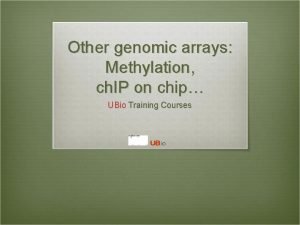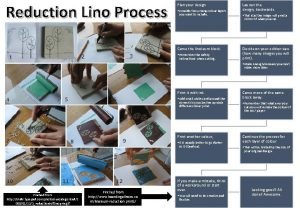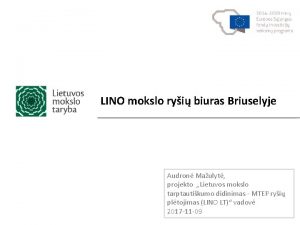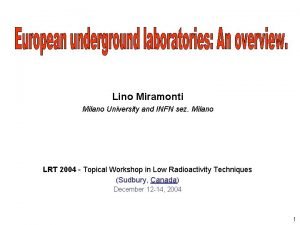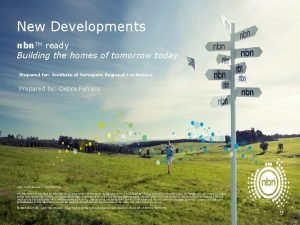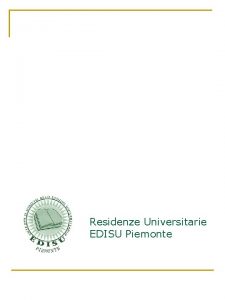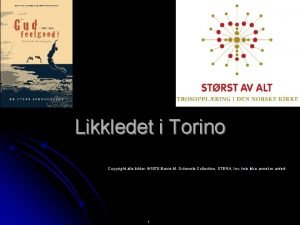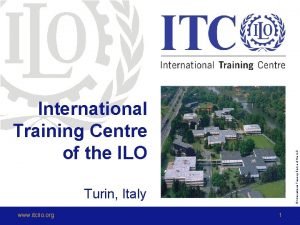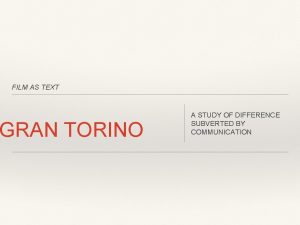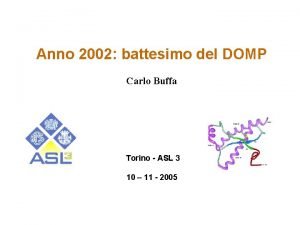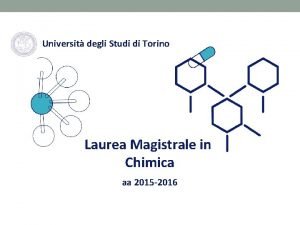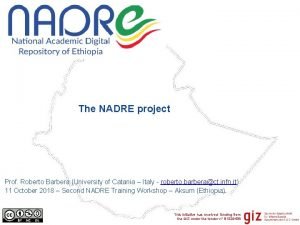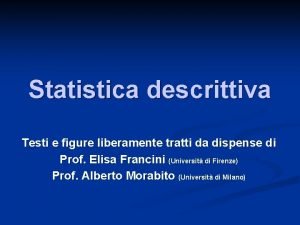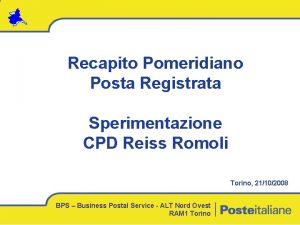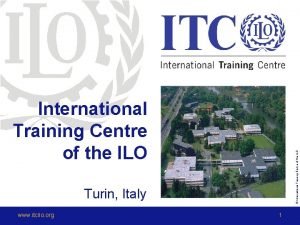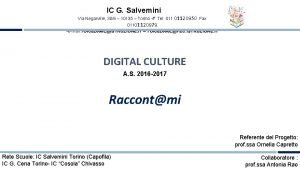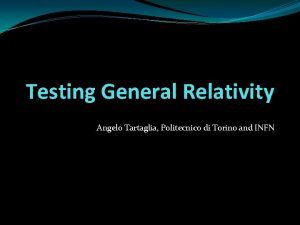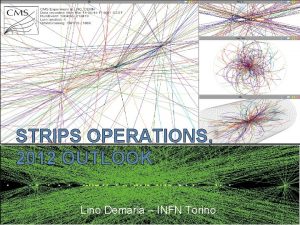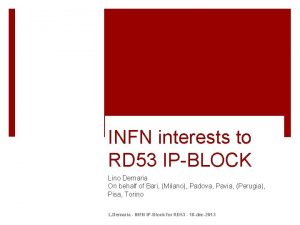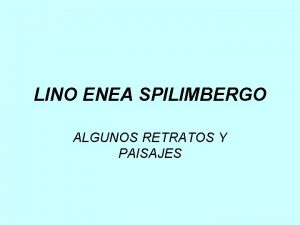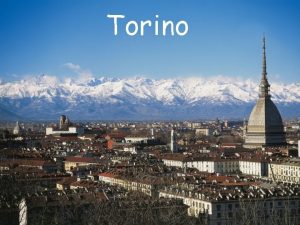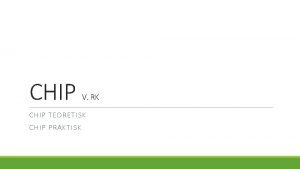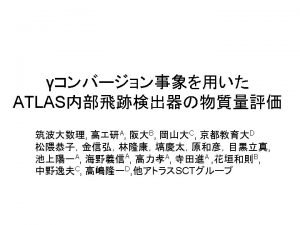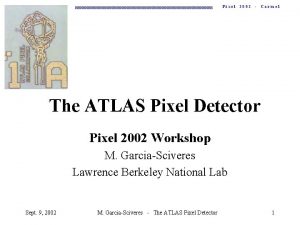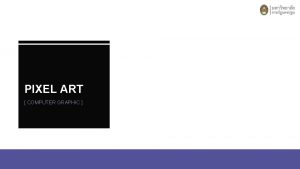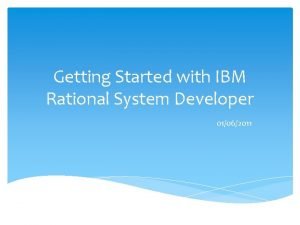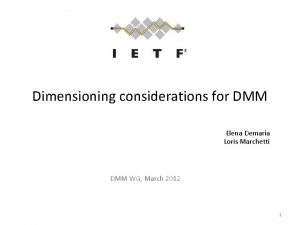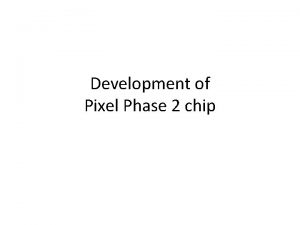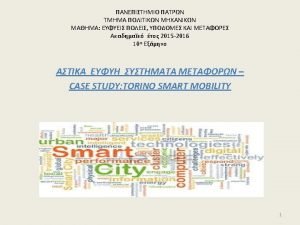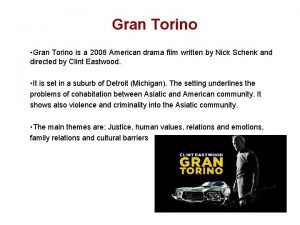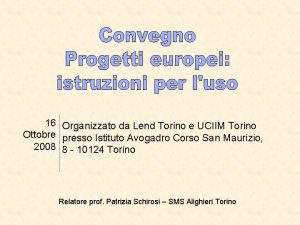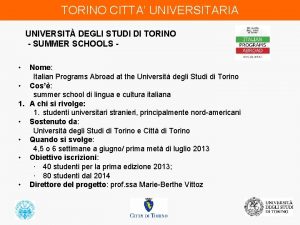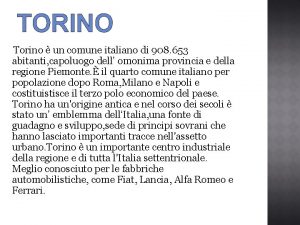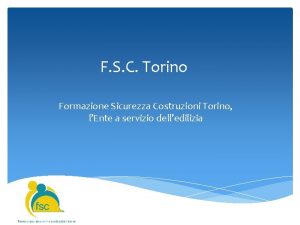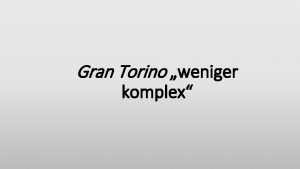Lino Demaria New Pixel Chip Torino 01062011 REQUIREMENTS





































- Slides: 37

Lino Demaria - New Pixel Chip - Torino 01/06/2011 REQUIREMENTS FOR A NEW PIXEL CHIP L. Demaria - Torino INFN

Layout of the presentation 1. Present and Upgraded ROC (CMS Pixel chip) 2. Atlas Chip(s) 1. A New chip for CMS Pixel Lino Demaria - New Pixel Chip - Torino 01/06/2011

Requirements for the new ROC Present ROC has been design for a max luminosity of L = 1034 cm-2 Hz � at inner radius R=4. 3 cm correspond to a particle flux of 40 MHz cm-2 Main features: � � � Pixel cell 100 mm x 150 mm analog readout, threshold of 3500 e. End of Column Drain architecture Technology 0. 25 mm Readout serial 40 MHz New ROC should maintain performance of present ROC at max luminosity of L = 2 1034 cm-2 Hz � At inner radius R=3. 9 cm correspond to a particle flux of 120 MHz cm-2 Strategy: � Maintain the heart of the pixel chip � � � pixel cell (PUC) Do. C architecture Lower threshold (1600 e- ? ) ? ? To be proved Digitize after Do. C Change of perifery Maintain the technology Readout serial 160 MHz Lino Demaria - New Pixel Chip - Torino 01/06/2011

• Read. Out Chip (ROC) bump bonded sensor pixels. • Pixel CELL (PUC): 100 mm x 150 mm • 52 × 80 = 4160 pixels per ROC • 15, 840 ROCs = 66 million pixels • zero-suppressed output • Each ROC can be tuned (DAC) • Each pixel has a programmable threshold (adjusting this is called trimming) • On receiving a L 1 trigger, the Token Bit Manager (TBM) initiates a Chinesewhisper of “token bits” that instruct each ROC to send its hit data to the TBM • The signal from the TBM is electrical and analog. It encodes the ROC #, row and column and charge collected of each pixel hit • The electrical signal from the TBM is converted to optical by the Analog. Optical Hybrid (AOH) Lino Demaria - New Pixel Chip - Torino 01/06/2011

Eo. C drain architecture No buffering at pixel level Huge buffer at End of Column (Eo. C) � Lot of (analog) data transfer to Eo. C: signal outside trigger are sent to Eo. C linear with pixel fluence � Column can go in Busy Trigger time stamp at Eo. C Pixel can go in busy (waiting to be readout) but it is continuously readout All data go to End of Double Column Time Stamp buffer linear with: Pix. Fluence; Trigger Latency (and also with trigger frequency) Readout Double Column & reset of DC data buffer Dead-time depends on: Pix. Flu * BX-time(25/50 ns); trigger frequency Lino Demaria - New Pixel Chip - Do. C occupancy at trigger latency: 19 -38 (Phase 1); 58 (Phase 2) Torino 01/06/2011

New ROC maintain same architecture of Do. C but increase buffering 1. 2. 3. 4. Increased buffering at Eo. C (from 12 to 80) Increase Time Stamp Buffer (12 to 24) Introduced Read. Out Buffer (0 to 80) Increased ROC readout clock (ROC at 160 MHz, TBM to 320 MHz) Lino Demaria - New Pixel Chip - Torino 01/06/2011

Readout of Old and New ROC Lino Demaria - New Pixel Chip - Torino 01/06/2011

Remaining Losses on New ROC for Layer 1, R=3. 9 cm, L=2 1034 cm 2 Hz Lino Demaria - New Pixel Chip - Torino 01/06/2011

Lino Demaria - New Pixel Chip - Torino 01/06/2011

Lino Demaria - New Pixel Chip - Torino 01/06/2011

Project for new beam pipe Lino Demaria - New Pixel Chip - Torino 01/06/2011

How is the Pixel Flux with the new beam pipe ? Lino Demaria - New Pixel Chip - Torino 01/06/2011

Estimation of fluxes with an Analytical Calculation – L=2 E 34 TECH. PROPOSAL WITH R=3. 9 cm (L 1) PSI Estimation My Estimation Pixel rate vs Theta NOW NEW PROJECT FOR BEAM PIPE REDUCED Radius R=2. 98 cm 2 Pixel Chip Lino Demaria - New RATE goes to ~500 MHz/cm Torino 01/06/2011

My comment: • Layer 2, 3 and 4 are clearly OK • Layer 1 has to be understood better Simulation Studies for the smaller beam pipe yet to be done. It will be interesting to see what are the consequences on the buffering at Eo. C and on the overall deadtime. Lino Demaria - New Pixel Chip - Torino 01/06/2011

What is Atlas Doing ? Lino Demaria - New Pixel Chip - Torino 01/06/2011

Present Atlas CHIP FEI 3: drain architecture, To. T, 0. 25 mm For Atlas chip, at 5 cm radius, L=3 1024 the chip reach saturation THIS IS the estimate of Pixel flux for L=3 E 34 with FEI 3 geometry Lino Demaria - New Pixel Chip - Torino 01/06/2011

FEI 4: new chip in 130 nm Regional architecture, � data memorized in Region of 4 PUCs � N-buffer to store data Data are canceled at ~99. 75% after trigger latency To. T is used for signal amplitude Only good data go to Eo. C at each trigger Lino Demaria - New Pixel Chip - Torino 01/06/2011

Pixel flux conditions for FEI 4 chip @ L=2 E 34 Interesting to see that in the end the pixel flux is ~same as for CMS phase 1. The smaller pitch is balanced by a smaller magnetic field (cvd) Lino Demaria - New Pixel Chip - Torino 01/06/2011

How many buffers ? For IBL 5 buffers have been chosen Lino Demaria - New Pixel Chip - Torino 01/06/2011

Trigger Latency is important Lino Demaria - New Pixel Chip - Torino 01/06/2011

To. T is important BX- chosen for IBL Lino Demaria - New Pixel 4 Chip Torino 01/06/2011 at 3. 7 cm

FEI 4 estimated overall inefficiency This was shown at ACES: not completely clear to me if this plot is compatible with previous plots… Lino Demaria - New Pixel Chip - Torino 01/06/2011 BTW: we need to remember Atlas still has to do HIGH rate tests to certify the performances

…. . NOW … Lino Demaria - New Pixel Chip - Torino 01/06/2011

We should ask ourself Why not using FEI 4 ? � or an adapted FEI 4 to the CMS pixel geometry ? � Change pixel geometry from 100 x 150 to 50 x 250 mm 2 Work with FEI 4 team ? Or we make a new chip ? � Take in mind FEI 4 in Atlas is for: � IBL phase 1 Layer (2), 3, 4 for phase 2 We should make a chip that ANSWER to the request of Phase 1 (2007 -2008), but with a target in mind of a L 1 in phase 2 where there will be new sensor technology Lino Demaria - New Pixel Chip - Torino 01/06/2011

Technical specs: main ingredients for the Loss Mechanisms in Pixel Cell How many signal have to be stored every BX: Pixel Flux. Determined by Particle and by Pixel cluster size, important: Pixel size in Rphi charge sharing due to Lorentz angle Pixel size in Z Sensor thickness Trigger Latency Pixel Dead Time � To. T Lino Demaria - New Pixel Chip - Torino 01/06/2011

Sizes comparisons Choice of Rphi � Should give same resolution as today Choice of Rz � � Resolution should remain superior than Atlas, we aim to remain as good as now Balance among dimension and area in the pixel Deterioration from high irradiation Dealing with digitalized information Still profiting from B=3. 8 T, should result larger than Atlas I would not go below the present 150 mm I would investigate if larger could be better Practical aspects are important too � We should be compatible with existing sensor material if we want to bond chip and sensor Rphi: 50 (several); 80 Z: 150 Lino Demaria - New Pixel Chip - Torino 01/06/2011

Choosing pixel size 1. Fall Forward solution is un-necessarly small in Z ( huge clusters) 2. Solution 75 x 150 should be at least equivalent to present one but more robust in term of R-phi resolution 3. Solution 75 x 200 should be evaluated. Rphi should be at lest as good at Atlas (magnetic field 3. 8 T) and Z resolution is still better than ATLAS but has more space in PUC 4. Solution 75 x 250 should be still as good as Atlas in term of resolution on both directions. Area available for electronics on pixel is 50% larger more electronics Lino Demaria - New Pixel Chip - Torino 01/06/2011 on pixel is possible

Pixel rate @L=(5 x 1034) for different pixel cells –thickness =280 micron NB: green dots are the cluster size (theta is revers Lino Demaria - New Pixel Chip - Torino 01/06/2011

THIS graph applies to the solution of buffering in the PUC the signal until next trigger is arrived (trigger latency =3. 2 microsec). 4 buffers allow to reach Phase 2 with <<1% losses; 5 buffers allow to reach Phase 2 with <<0. 1% losses; Lino Demaria - New Pixel Chip - Torino 01/06/2011 Here are not included dead time for reading out the Pixel once the trigger is arrived

THIS graph applies to the solution of buffering in the PUC the signal until next trigger is arrived (trigger latency =4. 0 microsec). 5 buffers allow to reach Phase 2 with <1% losses; 6 buffers allow to reach Phase 2 with ~0. 1% losses; Lino Demaria - New Pixel Chip - Torino 01/06/2011

Phase 2 is considering to have all sub-detectors supporting 6 micro-sec trigger la (Tracking Trigger takes time…) Lino Demaria - New Pixel Chip - Torino 01/06/2011

Lino Demaria - New Pixel Chip - Torino 01/06/2011

Sensor is important Lino Demaria - New Pixel Chip - Torino 01/06/2011

Pixel rate @L=(5 x 1034) for different pixel cells – thickness = 150 micron NB: green dots are the cluster size (theta is revers Lino Demaria - New Pixel Chip - Torino 01/06/2011

Conclusion New ROC is the main baseline for Phase 1 � � Good moment to start a project of a new chip: we should do it � Good conservative approach but it limited precisely by that (250 nm; PUC/architecture unchanged) Problems foreseen for Layer 1 already with R=3. 9 cm; they will not improve at 2. 98 cm We should set our technical specs above phase 1, studying phase 2 regime already We should profit from CMS case: same performance as Atlas (or better) with larger PUC Technology wise we should start with 130 nm but in future we should not forget larger integration scale (90/60/35 nm) Sensor will be an important ingredient to be taken into account � Thickness could allow better segmentation or higher rates Lino Demaria - New Pixel Chip - Torino 01/06/2011

BACKUP Lino Demaria - New Pixel Chip - Torino 01/06/2011

Atlas looking to the future Lino Demaria - New Pixel Chip - Torino 01/06/2011
 Dr wroble
Dr wroble Color 01062011
Color 01062011 Methylation & chip-on-chip microarray platform
Methylation & chip-on-chip microarray platform Pocketknife pledge
Pocketknife pledge Lino miramonti
Lino miramonti Lino verdenės šaltinis
Lino verdenės šaltinis Olan de lino
Olan de lino Lino biuras
Lino biuras Lino 20m2
Lino 20m2 4 plantas industriales
4 plantas industriales Licne zamenice latinski
Licne zamenice latinski Inno nazionale
Inno nazionale Eina per ugni nedega
Eina per ugni nedega Nbn requirements for new homes
Nbn requirements for new homes Via castelgomberto 73
Via castelgomberto 73 Master plan
Master plan Nata a torino nel 1909
Nata a torino nel 1909 Residenza cavour torino
Residenza cavour torino Kledet
Kledet Ilo international training centre
Ilo international training centre Gran torino movie essay
Gran torino movie essay Carlo buffa neurologo torino
Carlo buffa neurologo torino Vincenzo ilotte
Vincenzo ilotte Lm chimica unito
Lm chimica unito Nadre ethiopia
Nadre ethiopia Coppia torino
Coppia torino Torino recapito reiss romoli
Torino recapito reiss romoli Campus politecnico di torino
Campus politecnico di torino Itcilo torino
Itcilo torino Ic torino salvemini
Ic torino salvemini Promoclub torino
Promoclub torino San donato calcio torino
San donato calcio torino Angelo tartaglia politecnico torino
Angelo tartaglia politecnico torino Angelo tartaglia politecnico torino
Angelo tartaglia politecnico torino Torino
Torino Infn lnf webmail
Infn lnf webmail Carlo naldi
Carlo naldi Differenze tra scuola siciliana e dolce stil novo
Differenze tra scuola siciliana e dolce stil novo


